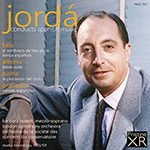
This album is included in the following sets:
This set contains the following albums:
- Producer's Note
- Full Track Listing
- Cover Art
Manuel de Falla’s El sombrero de tres picos (The Three-Cornered Hat) began life in 1917 as a modest pantomime with voice and chamber orchestra, based on Pedro Antonio de Alarcón’s picaresque novella of the same name. It was transformed two years later into a full ballet when the impresario Sergei Diaghilev commissioned Falla to expand it for his Ballets Russes. The resulting work, premiered in London in 1919 with designs by Pablo Picasso, stands as one of the high points of Spanish musical impressionism—a brilliant fusion of Andalusian colour, rhythmic vitality, and classical sophistication.
Falla’s score celebrates the earthy exuberance of Spanish folk tradition. Castanets snap, guitars strum, and the pulse of flamenco underpins much of the music, yet it is all filtered through the composer’s refined harmonic palette and structural mastery. Melodies rooted in folk song are transformed into dazzling orchestral dances: the Farruca, Jota, and Seguidillas explode with rustic energy, while moments of tenderness—especially in the miller’s wife’s music—reveal Falla’s gift for lyricism. Few works have captured so completely the spirit of Spain without resorting to pastiche.
The story itself is a farce of flirtation and comeuppance. A lecherous magistrate (whose titular hat denotes his rank) attempts to seduce a miller’s wife while her husband is away, only to be humiliated and exposed in a series of comic reversals. Falla’s music matches the humour beat for beat: sly woodwind figures accompany the magistrate’s pompous entrances, while raucous brass and percussion underline his ultimate disgrace. Beneath the comedy, however, lies Falla’s subtle portrayal of dignity and defiance in the common folk—a theme that resonated deeply in early 20th-century Spain.
El sombrero de tres picos remains a cornerstone of the Spanish orchestral repertoire, as exhilarating in the concert suite versions as in its full theatrical form. It bridges the worlds of concert hall and dance stage with rare brilliance, capturing in sound the sunlit wit and passion of Spain itself. Its collaboration with Picasso and Diaghilev also ensured a permanent place in the crosscurrents of modernism, where visual art, dance, and music fused into a singular Mediterranean vibrancy.
Enrique Jordá was one of Spain’s most cosmopolitan conductors, admired for his flair, rhythmic energy, and advocacy of Hispanic repertoire. Born in San Sebastián in 1911, he studied in Madrid and began conducting in the 1930s, but the turbulence of the Civil War pushed him to pursue an international career. After wartime years in South America, where he worked extensively in Argentina and Uruguay, Jordá rose rapidly as a guest conductor in Europe and the United States, gaining a reputation for his vivid interpretations and electric presence on the podium.
His big breakthrough came in 1954 when he became music director of the San Francisco Symphony, a post he held until 1963. There he brought a fresh, modern outlook to programming, championing contemporary music and introducing audiences to new composers from both sides of the Atlantic. Under his leadership the orchestra made several pioneering stereo recordings for RCA Victor, many of which showcased his dynamic, highly charged approach—particularly in the Latin repertoire he made his own.
Jordá’s style was unmistakable: rhythmically incisive, full of colour and spontaneity, sometimes even daringly impulsive. Critics occasionally noted that his interpretative passion could spill into volatility, but few denied the excitement he generated in performance. His collaborations with artists such as Clifford Curzon, for instance, in works by Falla and Ravel, reveal a conductor capable of both sensitivity and fire—a blend perfectly suited to the sensual brilliance of Spanish impressionism.
After his American years, Jordá returned to Europe, continuing to guest-conduct widely and record prolifically. He remained a tireless advocate for Spanish music, conducting El amor brujo, Noches en los jardines de España, and El sombrero de tres picos throughout his career. Though his name is less often mentioned today than some of his contemporaries, his recordings—especially those for Decca and RCA—testify to a musician of immense personality, whose energy and warmth captured something essential of Spain’s spirit in the concert hall.
JORDÁ conducts Spanish Music
FALLA El sombrero de tres picos
1. Introduction (1:34)
2. Part 1 - Afternoon (2:36)
3. The Procession (3:04)
4. Dance of the Miller's Wife (Fandango) (2:47)
5. The Corregidor (0:18)
6. The Miller's Wife (0:43)
7. The Grapes (4:15)
8. Part 2 - The Neighbour's Dance (Seguidillas) (3:08)
9. The Miller's Dance (Farruca) (3:07)
10. The Bodyguard (0:57)
11. The Miller's Wife (1:48)
12. The Clock (1:35)
13. Dance of the Corregidor (1:11)
14. The Corregidor and the Miller's Wife (2:13)
15. The Miller (2:23)
16. Final Dance (Jota) (6:12)
Barbara Howitt (mezzo-soprano)
London Symphony Orchestra
ALBÉNIZ (Orch. Arbós) Ibéria Suite
17. Book 1 - 2. El Puerto (4:11)
18. Book 2 - 3. Triana (4:35)
TURINA La Procesión del Rocío, Op. 9
19. 1. Triana en fête (2:57)
20. 2. La Procession (5:40)
GRANADOS (Orch. de Grignon) Danzas españolas
21. 5. Andaluza (4:07)
22. 2. Oriental (4:28)
23. 6. Rondalla aragonesa (4:55)
24. FALLA La Vida Breve - Danza Española No.1 (3:12)
Orchestre de la Société des Concerts du Conservatoire
conducted by Enrique Jordá
XR remastering by Andrew Rose
Cover artwork based on a photograph of Enrique Jorda
El sombrero de tres picos
recorded Walthamstow Assembly Hall, 23-24 November 1959
Presented in stereo
Other recordings
recorded La Maison de la Mutualité, Paris, 28 February 1950
Presented in Ambient Stereo
Total duration: 71:56

